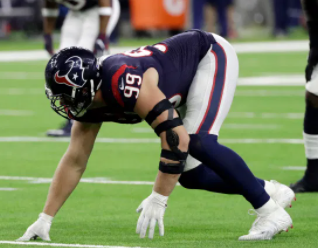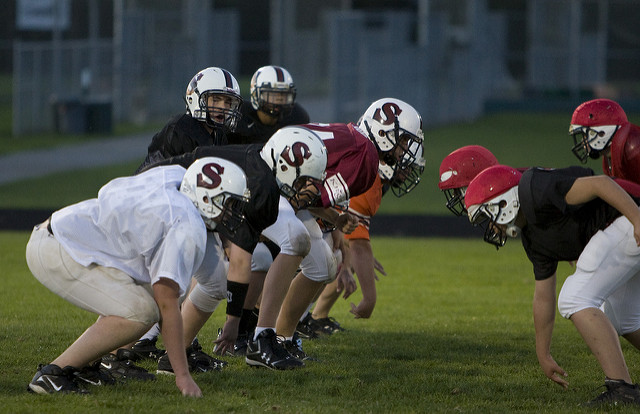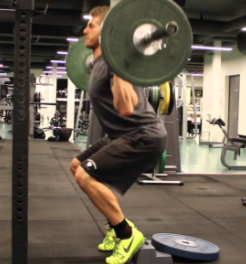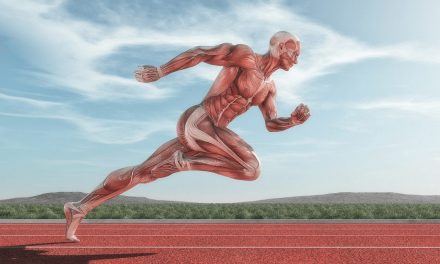In my last article I discussed 2 point stances, which leads to an obvious question of, “How do I teach the 3 point stance?”
Below is a list of coaching cues for each sprint drill, how to apply these thoughts to the field, how to troubleshoot, and where theory meets practicality.
We will first discuss the 3 point stance for speed drills and then we will show the differences between a speed stance and the defensive line stance and the offensive line stance.
If you have not already done so, please read my previous article and I would also recommend taking my FREE Coach Tube Course on Athletic Movement Principles because it will clarify many of the concepts below. If you do not want to take the whole course, you can just click on the videos for concepts where you require a deeper explanation.
3 Point Stance for Acceleration (Preparing For A Great Defensive Line Stance)
3- Point Stance For Acceleration Video
Asafa Powell Slow Motion Start Video
Teaching Track & Field Stances & Starts
LEGS
The front leg or “power leg” should be the opposite of the dominant hand and in most cases, right-handers will have their left leg forward. The back-leg will be the “swing leg”. This set up makes sense because when an athlete does a right-handed layup, they jump off the left leg while swinging the right knee up and a right-handed kicker plants on the left leg and swings with the right leg. That being said, athletes need to learn how to start with both legs forward because some wide receivers line up with different legs forward to ensure correct route footwork. For my players, I have always coached wide receivers to put their “power leg” in front because my goal was to break defensive back’s cushions and to get behind linebackers.
FEET
The weight of the body should be slightly more on the inside balls of the feet because that is where the feet push off to accelerate. Both feet should be hip width apart for forward movement.
KNEE ANGLES
The front knee angle should be 90° which creates a stretch reflex between the glutes and hamstrings and prepares the body for explosion. This is one of many reasons why it is important for athletes to squat to at least 90°.
The back knee angle should be around 120° because a swinging leg can produce more force if it is longer (a longer lever creates more force at the end of the lever than a shorter lever does). This is why a kicker or punter has their leg completely straight on impact. In this stance, the “swing leg” cannot be completely straight though because the back leg has to push off of the ground. It is impossible to jump without first bending the knees.
SHIN ANGLES
The front shin angle should be at 45°. This is important because when a player explodes out of their stance, the front shin’s angle is the biggest determiner of the initial takeoff angle. If an athlete knows where they want to go next, then they will always point their shin in that direction. If an athlete does not know where they will go next, then they will keep their shins vertical. This is why the shins of defensive basketball players are more vertical.
In terms of weight lifting, the principle of pointing the shins where you want to go next is applied to squatting since the first movement of squatting is “hips back”. “Hips back” keeps the shin more vertical and that is advantageous since the goal is to push the weight vertically. Bending the knees first will push the shins forward and will make it difficult to push the bar in the desired direction.
In terms of the 40 yard dash start, if you tell your athletes to stick their front-foot very close to the starting line, their shins will be too vertical to come out at a 45° angle and will cause them to stand up too quickly. Having the foot too close to the line also causes the knee angles to flip. The front knee incorrectly becomes an obtuse angle and the back knee incorrectly becomes a 90° angle. To ensure a proper beginning shin angle, the front foot should be about a shoe length away from the line and the back leg should be about 2-3 shoes lengths away from the line. Longer limbed athletes sometimes need their distances adjusted because of their body proportions. The following is a picture of a proper start for a left-handed athlete:
UPPER-BODY POSITION
The upper-body should be angled down at 45° to ensure that the athlete explodes out at 45°. This position applies the physics concept of the angle of incidence equalling the angle of reflection.
Between this upper-body alignment and the front shin position, athletes have almost no choice but to come out at a 45° angle. When athletes are in a proper position and still come out incorrectly it is usually because they try to “stay low” and are bent at the waist.
HEAD PLACEMENT
The head should be in a “neutral position” and there should be a 90° angle between the chin and the neck. If the head is not in a neutral position, the vertebrae will pinch the nerves and cause an athlete’s strength to diminish. Think about this in terms of what happens when you put a “kink” in a hose while the water is running. Also, when the head comes up the shoulders will rise and the hips will drop which will affect the 45° acceleration angle.
On the field, instead of teaching defensive lineman to lift their head and look at the ball, tell them to just tilt their head so their head is still in neutral position. While squatting, never tell your athletes to look towards the ceiling because it will affect their nervous system. To get the athletes to lift their chest, tell them to pull their elbows down and forward.
3 Point Stance Application To The Field
Defensive Line Stance:
- He is in a right handed stance since his left leg is forward.
- His head is up and not in a “neutral position” because he is looking straight ahead. If he is looking at the ball, his head will be in neutral.
- The front shin is at 45°.
- The front knee is at 90° and the back knee is about 120°.
- He is on the balls of his feet and is not flat-footed.
Offensive Line Stance:
Zone & Air Raid:
- The head has to be up so they can see the defensive lineman and communicate
- The front shin will be vertical since they have to move in a variety of directions
Goal-Line & Triple Option:
- Their shins are parallel to the ground because they want to get the lowest position possible and try to be the “lowest man”.
- Every offensive stance is geared to moving forward immediately.





